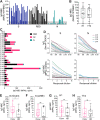S Protein-Reactive IgG and Memory B Cell Production after Human SARS-CoV-2 Infection Includes Broad Reactivity to the S2 Subunit
- PMID: 32978311
- PMCID: PMC7520599
- DOI: 10.1128/mBio.01991-20
S Protein-Reactive IgG and Memory B Cell Production after Human SARS-CoV-2 Infection Includes Broad Reactivity to the S2 Subunit
Abstract
The high susceptibility of humans to severe acute respiratory syndrome coronavirus 2 (SARS-CoV-2) infection, the cause of coronavirus disease 2019 (COVID-19), reflects the novelty of the virus and limited preexisting B cell immunity. IgG against the SARS-CoV-2 spike (S) protein, which carries the novel receptor binding domain (RBD), is absent or at low levels in unexposed individuals. To better understand the B cell response to SARS-CoV-2 infection, we asked whether virus-reactive memory B cells (MBCs) were present in unexposed subjects and whether MBC generation accompanied virus-specific IgG production in infected subjects. We analyzed sera and peripheral blood mononuclear cells (PBMCs) from non-SARS-CoV-2-exposed healthy donors and COVID-19 convalescent subjects. Serum IgG levels specific for SARS-CoV-2 proteins (S, including the RBD and S2 subunit, and nucleocapsid [N]) and non-SARS-CoV-2 proteins were related to measurements of circulating IgG MBC levels. Anti-RBD IgG was absent in unexposed subjects. Most unexposed subjects had anti-S2 IgG, and a minority had anti-N IgG, but IgG MBCs with these specificities were not detected, perhaps reflecting low frequencies. Convalescent subjects had high levels of IgG against the RBD, S2, and N, together with large populations of RBD- and S2-reactive IgG MBCs. Notably, IgG titers against the S protein of the human coronavirus OC43 were higher in convalescent subjects than in unexposed subjects and correlated strongly with anti-S2 titers. Our findings indicate cross-reactive B cell responses against the S2 subunit that might enhance broad coronavirus protection. Importantly, our demonstration of MBC induction by SARS-CoV-2 infection suggests that a durable form of B cell immunity is maintained even if circulating antibody levels wane.IMPORTANCE The recent rapid worldwide spread of SARS-CoV-2 has established a pandemic of potentially serious disease in the highly susceptible human population. Key issues are whether humans have preexisting immune memory that provides some protection against SARS-CoV-2 and whether SARS-CoV-2 infection generates lasting immune protection against reinfection. Our analysis focused on pre- and postinfection IgG and IgG memory B cells (MBCs) reactive to SARS-CoV-2 proteins. Most importantly, we demonstrate that infection generates both IgG and IgG MBCs against the novel receptor binding domain and the conserved S2 subunit of the SARS-CoV-2 spike protein. Thus, even if antibody levels wane, long-lived MBCs remain to mediate rapid antibody production. Our study results also suggest that SARS-CoV-2 infection strengthens preexisting broad coronavirus protection through S2-reactive antibody and MBC formation.
Keywords: COVID-19; IgG antibodies; SARS-CoV-2; memory B cells; spike protein.
Copyright © 2020 Nguyen-Contant et al.
Figures


References
-
- Zhou P, Yang XL, Wang XG, Hu B, Zhang L, Zhang W, Si HR, Zhu Y, Li B, Huang CL, Chen HD, Chen J, Luo Y, Guo H, Jiang RD, Liu MQ, Chen Y, Shen XR, Wang X, Zheng XS, Zhao K, Chen QJ, Deng F, Liu LL, Yan B, Zhan FX, Wang YY, Xiao GF, Shi ZL. 2020. A pneumonia outbreak associated with a new coronavirus of probable bat origin. Nature 579:270–273. doi:10.1038/s41586-020-2012-7. - DOI - PMC - PubMed
-
- Huang C, Wang Y, Li X, Ren L, Zhao J, Hu Y, Zhang L, Fan G, Xu J, Gu X, Cheng Z, Yu T, Xia J, Wei Y, Wu W, Xie X, Yin W, Li H, Liu M, Xiao Y, Gao H, Guo L, Xie J, Wang G, Jiang R, Gao Z, Jin Q, Wang J, Cao B. 2020. Clinical features of patients infected with 2019 novel coronavirus in Wuhan, China. Lancet 395:497–506. doi:10.1016/S0140-6736(20)30183-5. - DOI - PMC - PubMed
-
- Wu A, Peng Y, Huang B, Ding X, Wang X, Niu P, Meng J, Zhu Z, Zhang Z, Wang J, Sheng J, Quan L, Xia Z, Tan W, Cheng G, Jiang T. 2020. Genome composition and divergence of the novel coronavirus (2019-nCoV) originating in China. Cell Host Microbe 27:325–328. doi:10.1016/j.chom.2020.02.001. - DOI - PMC - PubMed
Publication types
MeSH terms
Substances
Grants and funding
LinkOut - more resources
Full Text Sources
Other Literature Sources
Miscellaneous

